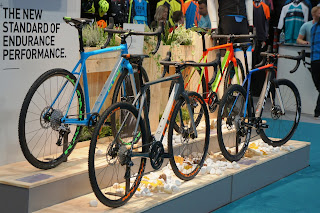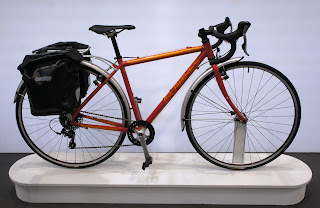Dynohub wheel components
safely in the hands of John Moss, I awoke at 6am on Monday morning…Decided then
was the moment to replace my fixed gear winter/trainer’s Aheadset. Gathered
headset, Czech made headset press, cyclo crown race setter and X tools’ removal
tool. The former, though used infrequently, make replacement surgery a breeze.
Convenience aside, they also
ensure delicate alloys and head tubes aren’t ruined. With care, it is possible
to improvise using blocks of wood and a hammer…If money’s tight, I’d buy the
press and crown race remover and employ a scrap length of 1/18th
down-tube to set the new one.
Everything came apart
effortlessly and the FSA Orbit XLII in place at 7.30bc (before coffee).
Cartridge bearings are impregnated with grease at the factory. Nonetheless, greasing
races is advised, to keep the elements, corrosion and ultimately, minimise
wear.
I plumped for some Finish line
ceramic around the lower bearing and Park PL1 around the upper. Forgot the
butyl boot, mind but opted to quit while the going was indeed, good. Grease
aside, the XL II is buttery smooth, confirmed by massive inner smile following
the morning’s celebratory 20mile blast.
The following evening, I
decided another helping of grease was in order. Clearly under the influence of
Rocket fuel, one lead to another and said machine now sports a slightly
more aggressive cockpit and Torus TI stem https://www.sevendaycyclist.com/torus-titanium-stem . Titanium can form an extremely stubborn bond,
so don’t forget good quality assembly paste to contact points. Or you might
find them inseparable a few months down the line…
The same applies to other
metals of mixed parentage-aluminium posts in steel frames, not to mention
bottom bracket threads, which perfectly positioned for lashings of dodgy water.
A decent glob of high quality synthetic grease prevents grief and copious
amounts of penetrant spray later on.
That done, I turned my
attentions to the Univega. Full length guards can extend maintenance intervals
quite considerably, especially when it comes to headsets; bottom brackets and
seatposts. Sealed cable systems, so long as they’ve been installed correctly
are very much fit n’ forget. Worth it, if you’re doing big miles in foul
weather.
Somehow, I managed to snag
one, where it routed into the rear derailleur. Replacing it with Jagwire pro
shift has sorted shifting gremlins. As I’d hope, the stainless steel inner with
pre-lubricated liner is super slick. Whether they’re truly fit n’ forget
remains to be seen.
Though fun is a big part of
winter riding, reliability is an equally significant buzzword. Wheels and tyres
being cases in point. I’m sticking with the Kenda small block8 and Schwalbe
Marathon 365 https://www.sevendaycyclist.com/schwalbe-marathon-gt365-tyre pairing. Spoke tension was a little on the
slack side, some minor wobble needed ironing out too.
Nowhere near Samba dancing
territory but a few minutes on the jig, saves a heap of hassle, not to mention
money later on. The rear was an off the peg, machine built affair. These have
become much more reliable but still tend to loose truth and tension faster, compared
with hand built hoops.
A good wheel builder knows
exactly how much to re-tension, whereas a machine can only work to programmed
settings. Nothing a wheelsmith can’t sort later on and wouldn’t trouble
me, on a lightly laden commuter, or training bike. The last thing I’d want on a
heavily laden tourer, tandem, or similarly specialised build.
Sans wheels, time to give the
frameset really thorough clean. This enables any damage to be spotted and
remedial measures taken. Ritual (at least in my republic) dictates that the
undersides of mudguards are also given a thorough scrub too. Minor stone chips
around the “school chair fork” were treated to a drop of high build marine
primer, left curing for 24 hours.
Finally I applied “helicopter
tape” where cables brush against the frame tubes and gave the entire bike a
liberal helping of Crankalicious crisp frame hybrid wax.
Pleasing to administer and seemingly
offering a durable, glossy barrier, I’ll hold judgement until November’s close.
This will give a much better indicator of its true performance, compared with a
more traditional hard-paste car type.
For the earlier part and,
depending on what comes in for testing I’ll be sticking with lighter, cleaner
chain lubes. As a genre, they lack the tenacity of wet blends but are generally
lower friction and attract less dirt.





















































